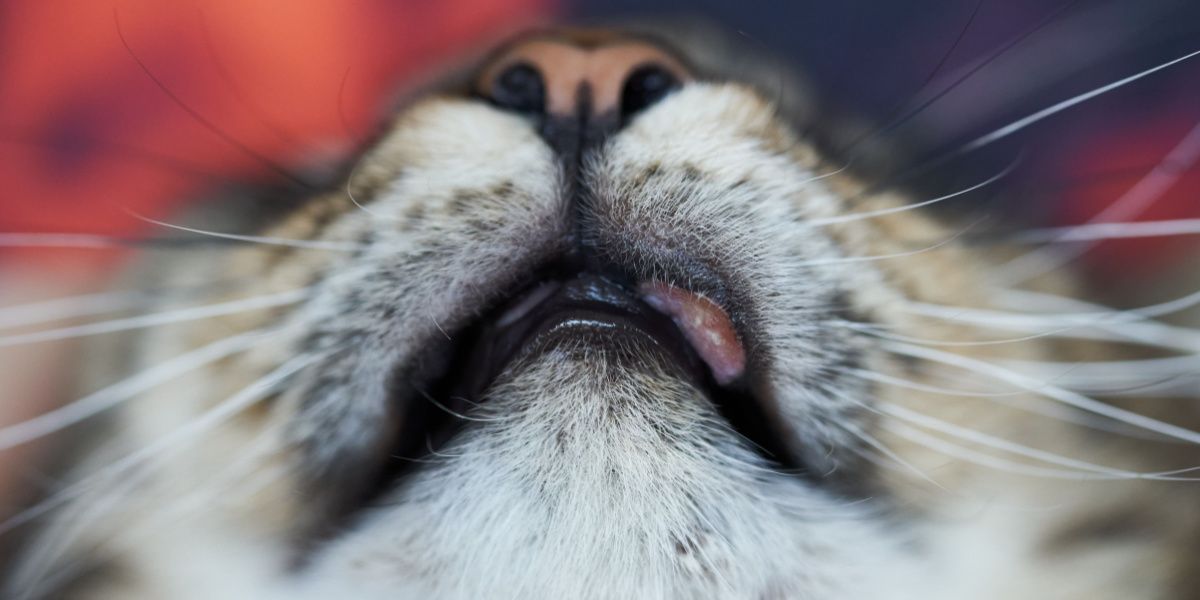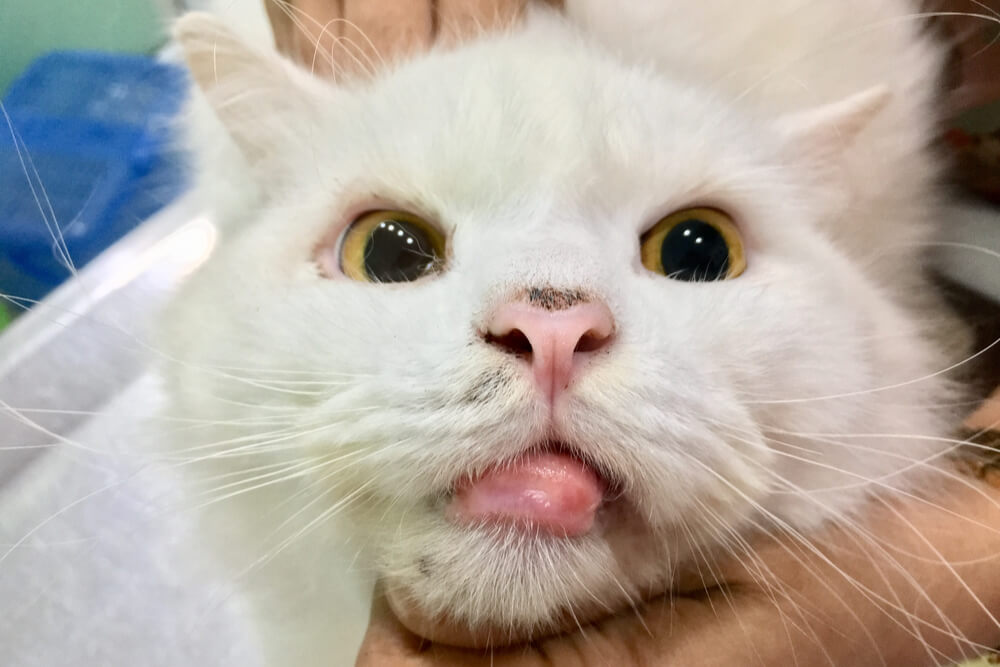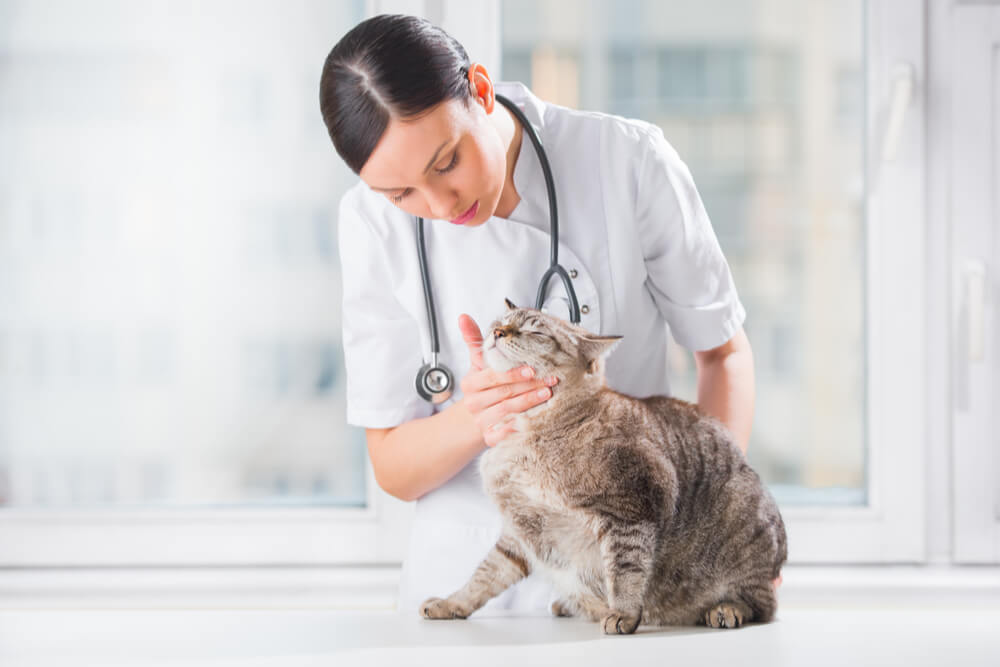
The eosinophilic granuloma complex (EGC) in cats is, well, complex. Rather than being a disease unto itself, the EGC is a collection of skin lesions that affect cats. In this article, we’ll tell you what you need to know about the eosinophilic granuloma complex in cats.
Quick Overview: Eosinophilic Granuloma Complex In Cats
 Other Names: EGC
Other Names: EGC
 Common Symptoms: A combination of lesions may be present including lesions that are ulcerated, appear as raised plaques, or as nodules or masses. Lesions often appear red and irritated and may appear on the abdomen, thighs, face, or mouth.
Common Symptoms: A combination of lesions may be present including lesions that are ulcerated, appear as raised plaques, or as nodules or masses. Lesions often appear red and irritated and may appear on the abdomen, thighs, face, or mouth.
 Diagnosis: Diagnosis typically based on tissue biopsy samples. Other tests to look for signs of bacterial or fungal infection. Underlying causes typically allergy-related with feeding trials and/or allergy testing to determine underlying allergy.
Diagnosis: Diagnosis typically based on tissue biopsy samples. Other tests to look for signs of bacterial or fungal infection. Underlying causes typically allergy-related with feeding trials and/or allergy testing to determine underlying allergy.
 Requires Ongoing Medication: Yes, in some cases.
Requires Ongoing Medication: Yes, in some cases.
 Vaccine Available: No
Vaccine Available: No
 Treatment Options: EGC is often related to an underlying allergy. Steroids often used initially. Ensure good flea control. Feeding trials with novel or hydrolyzed protein leading to dietary therapy and/or intradermal or blood allergy testing to develop allergy immunotherapy treatments. Other medications to suppress the immune system's response to allergens. Antibiotics for secondary skin infections.
Treatment Options: EGC is often related to an underlying allergy. Steroids often used initially. Ensure good flea control. Feeding trials with novel or hydrolyzed protein leading to dietary therapy and/or intradermal or blood allergy testing to develop allergy immunotherapy treatments. Other medications to suppress the immune system's response to allergens. Antibiotics for secondary skin infections.
 Home Remedies: While rarely possible, allergen avoidance at home may be possible in few cases. Over the counter antihistamines are rarely helpful.
Home Remedies: While rarely possible, allergen avoidance at home may be possible in few cases. Over the counter antihistamines are rarely helpful.
Basic Definitions
Before we talk about EGC lesions, let’s first go over some terminology. An eosinophil is an inflammatory cell that fights foreign invaders, like parasites, and can play a role in allergic reactions. These cells are full of granules that contain chemical substances that are released to destroy the invader.
A granuloma is a cluster of inflammatory cells that forms in response to inflammation.
What Causes the EGC?
There’s no definitive cause of the EGC. The most plausible cause is allergies, in that the lesions are an exaggerated response to an allergy, such as a food or flea allergy.
Genetics could be another cause.
It’s unknown how frequently the EGC occurs in cats. But the complex’s lesions tend to occur more frequently in female cats than male cats.
What Are EGC Symptoms?

The eosinophilic granuloma complex includes a variety of types of skin lesions in cats, including ulcers, plaques, and granulomas. Symptoms are varied and depend on the types of lesions involved.
Three lesions compose the EGC: indolent ulcers, eosinophilic plaques, and eosinophilic granulomas. Cats can have one or a combination of these lesions, which are described below.
Indolent Ulcer
Indolent ulcers are also known as eosinophilic ulcers. Their other name—rodent ulcers— is a misnomer. They form on the upper lip margins, usually toward the front of the upper lip.
The ulcers are firm, have distinct edges, and are orange-yellow. They range from being small to quite large and disfiguring. The upper lip may swell because of the ulcer.
Indolent ulcers can bleed but are not particularly painful or itchy.
Eosinophilic Plaque
Eosinophilic plaques can be found in several parts of the body, most commonly on the belly and inner thighs. Other locations include the anal area, throat area, chest, and under the front legs.
The plaques are thick and very itchy, causing lots of discomfort for cats. They have distinct edges and are circular, raised, and red. Hair loss is common near the plaques.
The plaques can become large. Cats tend to lick and bite at the plaques, increasing the risk of bacterial infection.
Eosinophilic Granuloma
Eosinophilic granulomas are also known as linear granulomas and collagenolytic (collagen-destroying) granulomas. Like the plaques, these granulomas can show up in many places on the body, most commonly on the lower lip, chin, back of the thigh, and inside the mouth. Granulomas on the lip or chin give cats a ‘pouty’ appearance.
Granulomas can also be found on the footpads, causing painful swelling and difficulty walking.
Granulomas are raised, pink-yellow, and are nodular or linear. Often, there is hair loss in the area. The skin around the granuloma is usually thickened and may be ulcerated.
The classic eosinophilic granuloma appearance is a linear lesion running down the thigh.
Granulomas are occasionally itchy.
How Is the EGC Diagnosed?
EGC lesions resemble those of other skin diseases, like bacterial infections or skin cancer. Therefore, a veterinarian would need to rule out these other diseases before confirming an EGC diagnosis.
To rule out these diseases, a veterinarian will analyze a small tissue sample under a microscope. To obtain a sample, a veterinarian will suction cells from the lesions (‘fine needle aspirate’) or take a small chunk of tissue via a biopsy.
Using the microscope, the veterinarian will look for eosinophils and other indications of inflammation. They’ll also look for microscopic evidence of ulceration. The microscopic features of an EGC lesion will help to distinguish it from other skin diseases.
A veterinarian will also try to determine if there is an allergic cause of the EGC lesions.
Strict flea control would help to identify a flea allergy. A food elimination trial, which involves feeding a limited-ingredient diet for up to several months, would identify a food allergy. An environmental allergy would be identified using under-the-skin injections of tiny amounts of potential allergens, like pollen.
Also Read: Mange in Cats: Symptoms, Diagnosis, & Treatment
How Is the EGC Treated?

While some cases of eosinophilic granuloma complex lesions resolve on their own, other cats will require steroid injections or tablets.
Ideally, the underlying cause of the EGC lesion is identified and treated. In most cases, though, an underlying cause can’t be identified; in these cases, treatment is symptomatic.
Sometimes, small or mild EGC lesions spontaneously resolve. Most lesions will need medical treatment.
Steroids are the most common treatment for EGC in cats. They suppress the immune system and can be given as long-acting injections or tablets. Because EGC lesions can recur throughout a cat’s lifetime, steroid treatment may be needed intermittently for life.
Steroids do a fantastic job of treating the lesions. However, they have downsides. Long-term steroid use has serious side effects, such as urinary tract infections and thinning skin. To minimize these side effects, other anti-inflammatory medications, such as cyclosporine, will be given in addition to steroids (to reduce the required steroid dosage) or instead of steroids.
Antibiotics are given to treat secondary bacterial infections.
Flea control is often a component of EGC treatment because flea bites can cause intense allergic reactions. A flea allergy could worsen EGC symptoms, so appropriate flea control is needed to reduce the risk of an even bigger allergic response.
If the EGC lesions are severe and don’t respond to treatment, advanced treatment by a veterinary dermatologist would be warranted.
Be aware that skin damage can be permanent even if the lesions are successfully treated. This skin damage is caused by the chemicals that are released by the eosinophils.
The EGC in cats is a complex and sometimes confusing medical condition. Take your cat to your veterinarian if you notice skin lesions that resemble the lesions described in this article. Prompt diagnosis and treatment will help to manage the lesions and help your cat feel more comfortable.








Hi Amber,
You’re welcome! I am not sure if squamous cell carcinoma and EGC are commonly confused.
Hello 😊 Zeke, my 7yo cat may have squamous cell carcinoma (vet said he may have, only took a needle aspirate b/c too likely to spread) behind tooth 108 since at least 9/14/23. I believe he has EGC. Are there any ways to tell the difference between the two of these that the vets could see via needle aspirate?
Hello Amber,
EGC can resemble many other diseases, so it can be diagnosed only by looking at a tissue sample under the microscope. One of the main features of EGC that can be seen under the microscope is the presence of eosinophils, a type of inflammatory cell. With squamous cell carcinoma, the main cell type is squamous cells, a type of skin cell. Describing all the microscopic differences between SCC and EGC can get quite technical and is beyond the scope of this commenting platform, so it is best to talk with your veterinarian about telling these two diseases apart using a fine needle aspirate.
Is it common to get the 2 confused?
Thank you very much for the response!
Oh, my estimates of the costs include several $60-$100 vet visits as well as the teeth extraction. He knows about the swollen paws. I have sent him pics. The cat adores him (!) and he hasn’t pushed for more complicated options although if I asked I am sure he’d support me. I’m in the situation where if I DID ask for an elaborate analysis of what Chee’s allergic to, what would I do then? The cure would be undoubtedly very expensive. Or would there be a cure? My impression is that there is not one.
My young rescue boy came home from the humane society with a note that he needed special food, and he has been on Hill’s z/d ever since although he sometimes steals a bite or two from my other cat’s food before I can stop him. He’s had his molars removed and there doesn’t seem to be any swelling around his incisors. He has been on prednosilone for several months now and we’re trying to transition off, but now he has a fat lip, and now he also has swollen rear paws. This does not seem to bother him – it did at first, but he doesn’t chew at them any more. He is about 2 years old, and still frisky. Has toys he lugs around and plays with, brings to be tossed, etc. Very interested in watching birds from indoors. In other words, no real sign of discomfort.
As long as there’s no sign of infection in the feet or mouth, can I just let him go along the way he is now and not try to get the swelling down in the feet? Preds if things get out of hand, but not try to chase down what he’s allergic to? I’ve spent about $3000 in the past eight months on him, and am reluctant to do any extensive treatments…
Hi Cee,
I’m glad that your cat is doing well overall and does not seem particularly bothered by the swellings on his lip and rear paws. To be on the safe side, I recommend speaking to your veterinarian about the swellings and describe when you first noticed the swellings and what they look like (size, color, etc.). It is understandable that you do not want to spend more on diagnostics and treatments, but it would be best to get advice from your veterinarian about how to manage the swellings.
JoAnna, Thank you for getting back with me. I went ahead and boarded Sawyer at noon yesterday I did`nt know what else to do?
JoAnna,This past Tuesday my 26 mo old male tabby“s vet diagnosed [EGC] in my cat`s left eye and prescribed Dexamethasone Sodium Phosphate Ophthalmic eye drops twice a day. First of all I have been unable to find any connection between EGC and eye problems! To come up with this diagnosis she took a [ In-house Cytology-2-3 slides* JoAnna do you think that this could be a miss diagnosis? Due too some health issues that I have I am unable to give those eye drops,when I told her that she told that the only too things I could do is to Board my baby for a week or so or she said something about an injection. I hope to hear from you, Thank You Bill
Hello, Bill. EGC doesn’t typically affect a cat’s eyes, but there is an inflammatory condition called eosinophilic keratitis that causes chronic inflammation of the cornea. Steroid medication is the recommended treatment option for eosinophilic keratitis. It is possible that your veterinarian incorrectly diagnosed your cat’s eye condition as EGC, but I cannot say for sure. She is correct, though, that steroid injections are an option. I’m not sure how boarding your cat would help your cat’s eye condition, but I would consider the injection as an alternative to the eye drops.
This is an excellent piece on this insidious complex. My boy has been suffering off and on since age 1.5 and he’s now 3.. We currently manage his EGC with prednisolone, but it tends to depress him which breaks my heart.
Can you please tell me whether or not research is still being done on this condition and possible treatments? Also why do cats seem to struggle with this so much?
Worried for my boy 🙁
My thanks,
T.
Hello Tia,
I’m so sorry to hear that your cat has been dealing with this complex. There has not been much research on the EGC in recent years, and the treatment options remain largely the same. If you haven’t already done so, let your veterinarian know that the prednisolone makes your cat depressed; your vet may recommend an alternative anti-inflammatory treatment.
There’s no definitive reason why the EGC primarily affects cats. Genetics could play a role, but this is rare.
Continue to do your best with treating your cat and work with your veterinarian to help your cat feel as comfortable as possible.